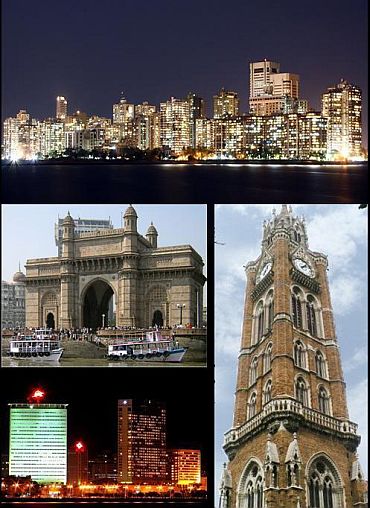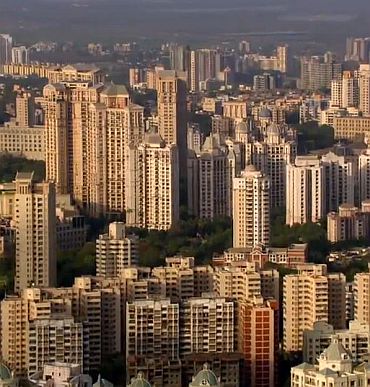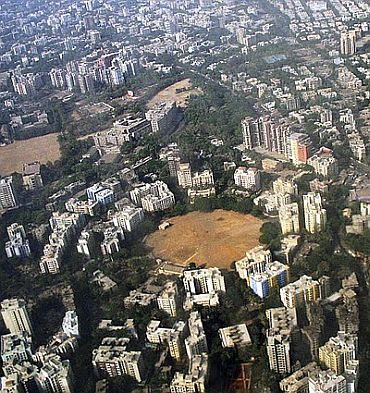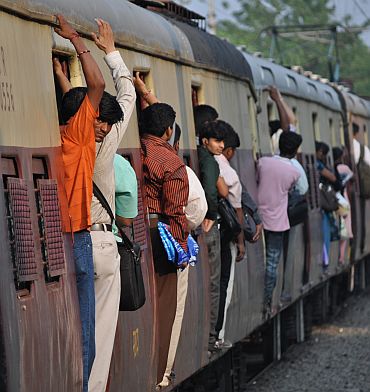 | « Back to article | Print this article |
Why has Mumbai ceased to attract migrants?
Is Mumbai hostile enough to migrants that they prefer other destinations for living -- different, of course, from a livelihood -- and if so, what is perceived to be the real threat? Could it be the nativist rhetoric and some violence to substantiate it? Or is it mere housing as an issue? Mahesh Vijapurkar throws some light on Mumbai's changing demographic pattern
The first decade of the new millennium could be of great import to Mumbai for it seems to have seen what hitherto was thought ever unlikely, at least by its ordinary citizens.
Going by the provisional data from Census 2011 released in April this year, the city has added about only half a million to its population between 2001 and 2011. It implies that the pressure on the city has somewhat eased though it continues to be the largest Indian city by population, and highest by their densities -- i.e., number of people per acre.
On the other hand, the birth and death data from the city government, the Municipal Corporation of Greater Mumbai shows that the natural increase, that is total births that occurred and were registered minus the number of total deaths among the citizenry during the same decade was 1.02 million.
Click on NEXT to read further...
Why has Mumbai ceased to attract migrants?
My friend Dr DP Singh, chairperson of Research Methodology, Tata Institute of Social Sciences, has collated this from the civic body's annual publications over the years. We agree that if both the census and the civic data are accurate, it points to an interesting demographic pattern. If not, the city needs to be studied again.
The natural increase by the existing population adding to its numbers was higher, and the total rise was less than what was thus added, pointing to several possibilities. One, the migration into the city has either slowed down, or in the extreme scenario, reversed.
That is, instead of coming in, people have chosen to move elsewhere from the El Dorado. The addition to the city on account of in-migration, by this logic was then actually negative, something which has never happened before.
Each of the three decades since 1901 had shown only negative natural increase and thereafter, it has been a mix of both, as per the census data over the years.
This, however, seems quite unreal unless there has been some deficiency in record keeping by the civic body or a possible miscount during the enumeration but one awaits the final data in a few months time.
Why has Mumbai ceased to attract migrants?
Has the city ceased to attract migration?
If it has, is it because housing has reached a point where it is just unaffordable? Or, have Mumbai residents who find life in the city quite tough, especially on their pockets because of astronomical real estate prices -- price of an apartment whose size is ever-shrinking or rentals beyond their reach -- have chosen different locations in the metropolitan region, taking up instead the challenge of harrowing commute to work and others have come to the city in their place?
Have they chosen Mumbai's satellite cities as alternative?
The spikes in the populations in these adjoining cities have spiked. Thane, Kalyan-Dombivli, Mira-Bhayandar and Navi Mumbai have acquired new residents who are equivalent to half of what they had in 2001.
Khargar, a node in Navi Mumbai has seen a 1,117 per cent surge in just a decade and such distant location like New Panvel more than doubled its population.
Why has Mumbai ceased to attract migrants?
Relatively cheaper housing to Mumbai's sky-scraping rates seems to have induced movement away from Mumbai.
In the absence of any employment opportunities in the cities, save perhaps to an extent in Navi Mumbai Municipal Corporation area, housing alone appears to be the magnet.
Mumbai is the preferred destination for livelihoods and the satellites the dormitories. But that is a rather sweeping a claim which would need to be tested now by demographers. The island city of Mumbai -- all to the South of Mahim Causeway and Sion -- has declined by 5.92 per cent, which means a good number of people also left the place.
Mumbai Suburban District -- from Mahim to Dahisar, Sion to Mankhurd and Mulund -- has increased and reasons for this can only be speculated upon.
The short question is: what are the contours of this flux that has seized the city. It would be worthwhile to know if the trends are firm, whether the tide has actually ebbed.
Why has Mumbai ceased to attract migrants?
Relatively cheaper housing to Mumbai's sky-scraping rates seems to have induced movement away from Mumbai.
In the absence of any employment opportunities in the cities, save perhaps to an extent in Navi Mumbai Municipal Corporation area, housing alone appears to be the magnet.
Mumbai is the preferred destination for livelihoods and the satellites the dormitories. But that is a rather sweeping a claim which would need to be tested now by demographers. The island city of Mumbai -- all to the South of Mahim Causeway and Sion -- has declined by 5.92 per cent, which means a good number of people also left the place.
Mumbai Suburban District -- from Mahim to Dahisar, Sion to Mankhurd and Mulund -- has increased and reasons for this can only be speculated upon.
The short question is: what are the contours of this flux that has seized the city. It would be worthwhile to know if the trends are firm, whether the tide has actually ebbed.
Why has Mumbai ceased to attract migrants?
It is relevant to recall that way back in the 1980s, the Municipal Corporation of Greater Mumbai had assessed the city's optimum population as being about 9 million by 2001 beyond which it would go into decline. That the tipping point was crossed quite ahead in time in 1991 itself, speaks volumes about the overcrowding justifying the metaphor 'bursting at the seams'.
We have seen how since the past few decades the city has been running on a treadmill, as it were, to remain in place. No amount of additional infrastructure is going to quite take the edge of the city's issues. They can at best marginally ease. A city with under 490 sq km is hard put to cope with such population load. A city without even elbow room.
Despite the slow down of population growth, Mumbai remains bustling than ever before, which points to how strengthening population trends in its satellite cities and towns have not changed the significance of Mumbai as a preferred destination for jobs.
More people commute in increasingly overcrowded trains, the numbers of which are thankfully going up. Also, more people are using cars and there are not just enough bus route options to commute to Mumbai.
Why has Mumbai ceased to attract migrants?
Again, it underscores the economic pre-eminence of Mumbai. And more daytime crowding of the city. If these cities continue to grow, would Mumbai be able to cope with the pressures? The entire metropolitan region requires to be recalibrated.
These satellite cities have a remarkable weakness. They think they are good dormitories and build the cities without building their economies. The interest seems to be serving the real estate lobbies, politicians and the officialdom.
The latter, as policy makers, have failed to realise that merely accommodating increasing people in their cities is pointless unless they are treated as human capital for stimulating their economies.
They seem so happy to be mere dormitories, for more people means greater demand for housing and high land prices. They translate into bigger rake-offs because of the ingrained venality in them.





